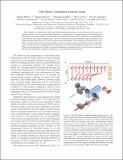Atom-by-atom assembly of defect-free one-dimensional cold atom arrays
Author(s)
Endres, Manuel; Bernien, Hannes; Keesling, Alexander; Levine, Harry; Anschuetz, Eric R.; Krajenbrink, Alexandre; Senko, Crystal; Greiner, Markus; Lukin, Mikhail D.; Vuletic, Vladan; ... Show more Show less
Downloadatomarray_paper_arxiv.pdf (5.895Mb)
PUBLISHER_POLICY
Publisher Policy
Article is made available in accordance with the publisher's policy and may be subject to US copyright law. Please refer to the publisher's site for terms of use.
Alternative title
Cold Matter Assembled Atom-by-Atom
Terms of use
Metadata
Show full item recordAbstract
The realization of large-scale fully controllable quantum systems is an exciting frontier in modern physical science. We use atom-by-atom assembly to implement a platform for the deterministic preparation of regular one-dimensional arrays of individually controlled cold atoms. In our approach, a measurement and feedback procedure eliminates the entropy associated with probabilistic trap occupation and results in defect-free arrays of over 50 atoms in less than 400 milliseconds. The technique is based on fast, real-time control of 100 optical tweezers, which we use to arrange atoms in desired geometric patterns and to maintain these configurations by replacing lost atoms with surplus atoms from a reservoir. This bottom-up approach may enable controlled engineering of scalable many-body systems for quantum information processing, quantum simulations, and precision measurements.
Date issued
2016-11Department
Massachusetts Institute of Technology. Department of Physics; Massachusetts Institute of Technology. Research Laboratory of ElectronicsJournal
Science
Publisher
American Association for the Advancement of Science (AAAS)
Citation
Endres, Manuel, Hannes Bernien, Alexander Keesling, Harry Levine, Eric R. Anschuetz, Alexandre Krajenbrink, Crystal Senko, Vladan Vuletic, Markus Greiner, and Mikhail D. Lukin. “Atom-by-Atom Assembly of Defect-Free One-Dimensional Cold Atom Arrays.” Science (November 3, 2016).
Version: Author's final manuscript
ISSN
0036-8075
1095-9203